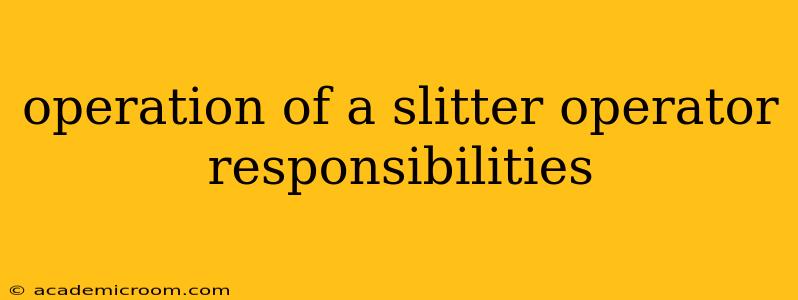A slitter operator plays a crucial role in the manufacturing process, transforming large rolls of material into smaller, more manageable widths. This detailed guide explores the responsibilities of a slitter operator, encompassing the machine's operation, quality control measures, and essential safety protocols. We'll also delve into frequently asked questions surrounding this vital role.
What are the Main Responsibilities of a Slitter Operator?
The primary responsibility of a slitter operator is to efficiently and safely operate a slitting machine to produce accurately sized and high-quality slit rolls of materials. This involves a range of tasks, including:
- Setting up the machine: This includes adjusting the blade settings to achieve the desired slit widths, aligning the material correctly, and setting the tension and speed according to specifications. Precision is key here to prevent defects and waste.
- Monitoring the slitting process: Continuous observation is vital to ensure the machine operates smoothly and the material is being slit accurately. This involves checking for any irregularities, such as misalignment or blade damage, and making necessary adjustments.
- Quality control: Inspecting the finished slit rolls for defects like uneven cuts, scratches, or wrinkles. This ensures the final product meets quality standards and client specifications. Often, this involves using measuring instruments to verify dimensions.
- Maintaining the machine: Performing routine maintenance, such as cleaning, lubricating, and replacing worn parts. Preventative maintenance minimizes downtime and ensures the machine's longevity.
- Packaging and labeling: Preparing the finished slit rolls for shipment by properly packaging and labeling them according to company and customer requirements.
- Troubleshooting: Identifying and resolving minor operational issues independently. Knowing how to identify common problems and implement solutions is vital to minimize production delays.
- Following safety procedures: Adhering to all safety regulations and using appropriate personal protective equipment (PPE), including safety glasses, gloves, and hearing protection, is paramount. This is crucial for preventing accidents and injuries.
- Record Keeping: Maintaining accurate records of production runs, including material used, slit widths, and any quality issues encountered. This ensures traceability and helps identify potential areas for improvement.
What Skills are Necessary to be a Successful Slitter Operator?
Beyond the technical aspects, several key skills contribute to success as a slitter operator:
- Mechanical aptitude: A strong understanding of mechanical principles and the ability to troubleshoot mechanical problems is essential.
- Attention to detail: Accuracy and precision are critical for producing high-quality slit rolls.
- Problem-solving skills: The ability to identify and solve problems quickly and efficiently is essential to minimize downtime.
- Physical stamina: The job can be physically demanding, requiring prolonged standing and lifting.
- Teamwork: Effective collaboration with other team members is often required for smooth workflow.
What is the Difference Between a Slitter and a Rewinder?
While both machines work with rolls of material, their functions differ significantly. A slitter cuts a wide roll into narrower rolls, while a rewinder rewinds the material onto new cores, often after it has been slit. Often, a single machine will incorporate both slitting and rewinding capabilities.
What are the Common Materials Slit by Slitter Operators?
Slitter operators work with a variety of materials, including:
- Paper: Various types of paper, including newsprint, packaging paper, and specialty papers.
- Film: Plastic films, such as polyethylene, polypropylene, and cellophane.
- Foil: Aluminum foil and other metallic foils.
- Fabric: Textiles and non-wovens.
- Other materials: Depending on the industry, other materials such as adhesive tapes or composites may also be processed.
What Safety Precautions Should a Slitter Operator Take?
Safety is paramount in this role. Operators must always:
- Wear appropriate PPE.
- Follow all lock-out/tag-out procedures.
- Regularly inspect the machine for any potential hazards.
- Report any unsafe conditions immediately.
- Understand and follow emergency procedures.
This comprehensive overview provides a solid understanding of the operation of a slitter and the responsibilities of a slitter operator. Remember, safety and precision are paramount in this critical manufacturing role.
